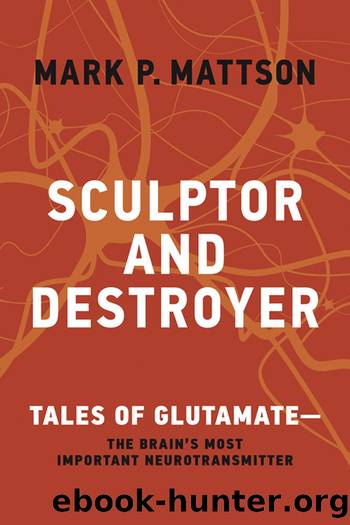Sculptor and Destroyer by Mark P. Mattson;

Author:Mark P. Mattson; [Mattson, Mark]
Language: eng
Format: epub
Tags: Addiction; Alzheimer�s disease; AMPA receptor; Amygdala; Amyotrophic lateral sclerosis; Anxiety; Astrocyte; Autism; BDNF (brain-derived neurotrophic factor); CB1 receptor; Dendritic spine; Depression; Dopamine; Engram; Epilepsy; Excitotoxicity; GABAGLP-1; Glucose transporter; Hippocampus; Huntington�s disease; LTP (long-term potentiation); Marijuana; Methamphetamine; Microglia; Nitric oxide; NMDA receptor; Opioid; Optogenetic; Parkinson�s disease; Prefrontal cortex; Presynaptic terminal; Psilocybin; Schizophrenia; Serotonin; Stroke; TBI (traumatic brain injury)
Publisher: MIT Press
Published: 2023-07-12T00:00:00+00:00
Parkinsonâs Disease
More than one million people in the United States are currently living with Parkinsonâs disease. Someone with this disease experiences progressively worsening difficulty in properly controlling the movement of their limbs. Shakiness of the hands is often the first problem noticed by the patient, although they may also have some difficulty walking and muscle stiffness. These so-called motor manifestations of Parkinsonâs disease are a consequence of the degeneration of neurons in the substantia nigra, located in the upper part of the brainstem. The neurons in the substantia nigra that degenerate use the neurotransmitter dopamine, and their activity normally prevents unwanted body movements. During the early stages of the disease, many dopaminergic neurons remain alive but are unable to produce dopamine. The motor symptoms can be relieved by giving levodopa to people with Parkinsonâs, a molecule that dopaminergic neurons can convert directly into dopamine. However, levodopa does not slow the degeneration and death of the neurons.
As with Alzheimerâs disease, most cases of Parkinsonâs disease occur late in life and have no known genetic cause. The actor and science enthusiast Alan Alda, the evangelist Billy Graham, and the singer Linda Ronstadt are examples of people diagnosed with Parkinsonâs when they were in their sixth, seventh, or eighth decade of life (although Ronstadtâs diagnosis was later changed to progressive supranuclear palsy). One risk factor for Parkinsonâs disease is a history of head trauma. There is also evidence that repeated exposures to certain pesticides, such as rotenone, can increase oneâs risk for Parkinsonâs. In chapter 6, you learned about natural and man-made neurotoxins that damage and kill neurons by excitotoxicity. Some of those toxins, such as kainic acid and domoic acid, directly activate glutamate receptors excessively. Others, such as the pesticides rotenone and paraquat, cause excitotoxicity indirectly by impairing the function of mitochondria in neurons. Because of their high firing rates and energy requirements, dopaminergic neurons are particularly vulnerable to such mitochondrial toxins.
The actor Michael J. Fox was diagnosed with Parkinsonâs at the age of 29. Developing Parkinsonâs at such a young age is uncommon and is usually caused by an inherited gene mutation. From the public record, it is not clear whether one of his parents had early-onset Parkinsonâs. According to Wikipedia, Fox believes he may have been exposed to a chemical that caused his Parkinsonâs disease: âI used to go fishing in a river near paper mills and eat the salmon I caught; Iâve been to a lot of farms; I smoked a lot of pot in high school when the government was poisoning the crops. But you can drive yourself crazy trying to figure it out.â
Approximately 5 percent of Parkinsonâs disease cases are inherited. People with inherited Parkinsonâs disease typically begin to exhibit symptoms when they are in their thirties, forties, or fifties. In 1997, geneticists at the US National Institutes of Health reported the identification of a gene mutation associated with inherited Parkinsonâs disease in an Italian family (Polymeropoulos et al. 1997). The mutation is inherited in an autosomal
Download
This site does not store any files on its server. We only index and link to content provided by other sites. Please contact the content providers to delete copyright contents if any and email us, we'll remove relevant links or contents immediately.
Governing Habits: Treating Alcoholism in the Post-Soviet Clinic by Eugene Raikhel(233)
TSRA Operative Dictations in Cardiothoracic Surgery by unknow(194)
Cardiology in a Heartbeat, second edition by Vaswani Amar;Khaw Hwan Juet;El-Medany Ahmed;Dougherty Scott;(192)
The Rosetta Stone of the Human Mind by Vincenzo R. Sanguineti(189)
The Trauma Chronicles by Westaby Stephen(160)
If Joan of Arc Had Cancer : Finding Courage, Faith, and Healing from History's Most Inspirational Woman Warrior by Janet Lynn Roseman(158)
Lymphedema (Lymph Obstruction), a Simple Guide to the Condition, Diagnosis, Treatment and Related Conditions by Kenneth Kee(153)
How Selegiline ((-)-Deprenyl) Slows Brain Aging by Joseph Knoll(153)
Clinical Nephrology - 2020 by Weber MD C. G(150)
The Heart Health Bible by John M. Kennedy(150)
Dear Millie: Diary of a seven year old with cancer by Marco Previero(144)
Fast Facts: Skin Cancer by unknow(139)
Restful Insomnia by Sondra Kornblatt(135)
Community Engagement, Organization, and Development for Public Health Practice by Murphy Frederick;Frederick Murphy Msphyg Mpia;(133)
Home and Dry by Birgit Bulla(132)
Rethinking Evidence in the Time of Pandemics: Scientific vs Narrative Rationality and Medical Knowledge Practices by Eivind Engebretsen Mona Baker(132)
Fibromyalgia--Your Treatment Guide by Christine Craggs-Hinton(130)
What Your Doctor May Not Tell You About Cholesterol by Stephen R. Devries & Winifred Conkling(128)
Medical Materialities by Aaron Parkhurst Timothy Carroll(125)
